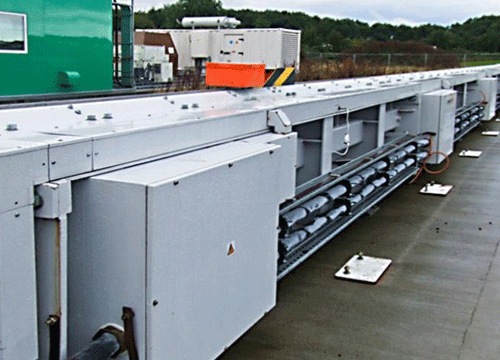 |
| March 19, 2013 | Volume 09 Issue 11 |
Designfax weekly eMagazine
Archives
Partners
Manufacturing Center
Product Spotlight
Modern Applications News
Metalworking Ideas For
Today's Job Shops
Tooling and Production
Strategies for large
metalworking plants
Wheels (and wings):
New electromagnetic catapult includes 'most powerful single linear motor ever energized'
GE Power Conversion has completed stall testing on a new advanced linear induction machine, a core component in the EMCAT (Electro Magnetic CATapult) launch track system designed to launch manned and unmanned aircraft from various platforms.

GE Power Conversion's catapult at the Bruntingthorpe test site in Leicestershire, England.
Catapults incorporating the powerful new medium-voltage advanced linear induction machine (MV ALIM) will be capable of launching aircraft as large as the latest F35-C from aircraft carriers, while smaller versions (EMKITs) will be used to launch unmanned aerial vehicles (UAVs) from mobile or fixed installations. The machine can quickly accelerate to speeds in excess of 186 mph and generate gravitational forces of 3.3 g. For shorter launches, the technology can reach as much as 12 g.
The MV ALIM can produce more than 230 kN of thrust, the tests showed. Graham Bellamy, senior engineering leader at GE Power Conversion, Naval, believes that in terms of thrust density, this is the most powerful single linear motor ever energized. One notable feature is that the catapult starts slow, like a theme-park roller coaster using similar technology, and attains maximum speed at launch. This is a benefit to jet pilots.
"The tests on the MV ALIM are the culmination of more than a decade of substantial investment and development in EMCAT," Bellamy says. "Stall testing satisfied all major test objectives of this new MV ALIM. Thousands of launches have been proven previously on the smaller EMKIT variant, which allows aircraft weighing up to 11 tons at speeds of up to 50 meters per second to be launched. Smaller aircraft can be accelerated to speeds of up to 120 meters per second."
The new EMCAT MV ALIM provides launch options for a wider range of aircraft take-off weights, ranging from 50 kg to more than 32 tons. The unique modular design of the machine frames, together with the pulsed power supply and conversion and switching systems, provide scalable launch track lengths to suit various maximum aircraft launch weight capacities and launch platforms -- effectively tailoring runway length as required. The extensive use of commercial off-the-shelf equipment has helped contain costs while increasing availability and technology readiness levels.
The simplicity and power of the EMCAT system comes from careful design and integration. Ergonomic operator panels allow precise control over all major variables. No trackside sensors are required for launch speed control (substantially reducing component count compared with similar systems), and variations in airframe speed during launch are automatically compensated. Furthermore, these intrinsic characteristics minimize variation of thrust (ripple) onto the airframe to maximize both airframe campaign life and utilization of airframe capacity.
"Traditional steam launch catapults rely on steam-raising plants that are large, complex, and expensive to buy, run, and maintain," says Bellamy. "That was not so much of a problem when ships needed to produce steam for various purposes, not just for launching aircraft. But today, ships don't need so much steam, so boilers of the size and type required for catapults are rare. But modern navy ships do have large electrical generating capacity. This can be used to satisfy the needs of EMCAT in short bursts."
Bellamy points out other advantages for linear motors: "A magnetic launch should be kinder to airframes, since it can be applied in a more controlled way than steam catapults that apply their force in an explosive burst. In addition, steam catapults have a finite recharging period, whereas EMCAT and EMKIT are virtually instantaneous. Many UAVs rely on explosives or rockets to get airborne, which is costly. EMKIT could represent a financial savings and a potential to increase mission capability."
GE Power Conversion Naval Director Mark Dannatt notes a recent tendency by the company's major customers toward developments focusing on joint unmanned aircraft system (UAS) approaches. He also sees interest in UAS growing among non-defense as well as defense organizations.
"Drawing on our extensive experience over decades in the electrical power conversion systems industry, we are moving to provide launch systems for almost any aircraft as a complete package," Dannatt says. "This would include launch attachments, recovery systems, and both fixed and mobile launch platforms, as well as integration into existing launch platforms. We are able to provide customers with a one-stop shop for all their UAS launch system requirements."
GE acquired Power Conversion (then known as Converteam) in September 2011. Learn more at www.ge-energy.com/electrifyingchange.
Source: GE Power Conversion/GE Reports
Published March 2013
Rate this article
View our terms of use and privacy policy
